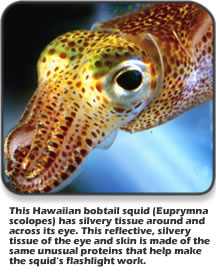

Information Related to "A Challenge to Evolution--On the Beach!"
 | Audio/Video |
![]() Hey, look at the surf!" Aaron exclaimed, as the beach party was winding down that night. A number of us approached the seashore and were awed by a beautiful green luminosity flashing through the crashing waves. This phenomenon, called bioluminescence, is caused by millions of tiny bacteria lighting up their cells as they are tossed by the surf.
Hey, look at the surf!" Aaron exclaimed, as the beach party was winding down that night. A number of us approached the seashore and were awed by a beautiful green luminosity flashing through the crashing waves. This phenomenon, called bioluminescence, is caused by millions of tiny bacteria lighting up their cells as they are tossed by the surf.
Little did I imagine I was witnessing evidence against the theory of evolution.
 Off the coasts of Hawaii, the bobtail squid uses this type of luminescent bacteria as a flashlight to hide its shadow from its predators and to feed. The amount of light from the bacteria, kept in an organ on the underside of the squid's body, is controlled by a lens. The squid can sense the intensity of light from the sky and modify its glow, so that the animal, seen from below, matches the background.
Off the coasts of Hawaii, the bobtail squid uses this type of luminescent bacteria as a flashlight to hide its shadow from its predators and to feed. The amount of light from the bacteria, kept in an organ on the underside of the squid's body, is controlled by a lens. The squid can sense the intensity of light from the sky and modify its glow, so that the animal, seen from below, matches the background.
It is one of creation's most remarkable examples of symbiosis—the living together of two dissimilar organisms in a mutually beneficial relationship—something that gives evolutionists major headaches.
How a squid developed its complex ability to capture and use tiny luminous bacteria exactly on the right part of its body, create a lens for it and even regulate the light is something scientists cannot explain. One group of experts admitted, "[Since] most animal-bacterial associations cannot be experimentally initiated, the mechanisms underlying the processes…have not been explored" ("Competitive Dominance Among Strains of Luminous Bacteria…in Squid-Vibrio Symbioses," University of Hawaii, June 22, 1998).
There are many factors that have to be exactly right to achieve what the squid can do. Evolution, in contrast, insists animals have evolved in a step-by-step process through the blind forces of random mutation and natural selection.
Yet squid, as other animals, operate on instinct—a programmed mode of behavior and survival. They are not conscious of what they are doing. They simply do it—to our utter amazement.
This particular squid remains buried in the sand during the day and comes out to feed at night. That's when its amazing ability literally shines in the darkness. How does it do it?
Shortly after birth, the squid begins to accumulate the right type of bacteria (Vibrio fischeri) from the thousands of organisms present in seawater.
As one scientist wrote: "The ability of the bobtail squid to shine its light organ…hinges on the luminescence of the symbiotic bacteria Vibrio fischeri. Among the thousands of creatures swimming in the ocean…Vibrio fischeri bacteria and bobtail squid apparently only have eyes for each other. The squid allows one particular bacteria to colonize it while excluding all other types" (John Roach, "Squid's Built-In Light to Inspire New Gadgets," National Geographic News, Jan. 8, 2004, online version).
Hmm—very interesting. A squid knows exactly which bacteria to choose from the thousands out there. How could this have happened by chance? Does creation or evolution make more sense in this example?
Furthermore, it is amazing how these bacteria light up only when a sufficient number come together—and we are talking about millions of them! A single bacterium produces only a tiny flash of light that would be useless to the squid. But through a process called quorum sensing, once a critical mass of these organisms has been reached, they communicate to synchronize this powerful burst of light—precisely what the squid needs to camouflage its shadow on moonlit nights.
So the squid benefits from this bacteria and, in turn, the bacteria benefit from the squid by being fed precisely the right elements they needs—carbon and nitrogen in the form of proteins and peptides. Now, how did the squid learn through mindless evolution what the bacteria eat? Did it try out different foods until, by accident, the bacteria were finally satisfied and agreed to stay? This sounds utterly ludicrous—but you won't hear evolutionary scientists admitting the inherent dilemma.
Beyond this is another factor here that makes evolutionary explanation even less believable than it should be anyway. The squid has what might seem to be a problem in that it feeds too many bacteria every day. This is resolved by special vents it has that flush out 95 percent of the bacteria each morning! While this loss would seem to be another problem, it turns out not to be because the bacteria reproduce precisely the same number during the day and therefore are ready to become the squid's reliable flashlight for its nighttime forays.
Everything fits hand in glove—each stage is as carefully orchestrated as a ballet.
All of this clearly shows purposeful behavior—that two completely different creatures were literally meant for each other and need each other to survive. Yet so many steps had to be in place at the same time for this vital partnership to work. Just one missing component would send the whole delicate process crashing down.
Again, the question is: what makes more sense as the means of producing this incredible symbiosis—creation or evolution? VT
About the author:Related Information:
Table of Contents that includes "A Challenge to Evolution--On the Beach!"
Other Articles by Mario Seiglie
Origin of article "A Challenge to Evolution--On the Beach!"
Keywords: evolution squid symbiosis
Evolution and biology: